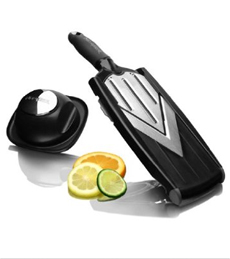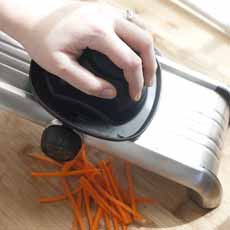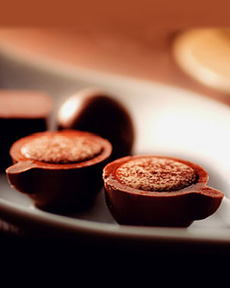|
It’s National Compote Day.
What’s a compote?
Compote de fruits, or fruit compote, is mixed stewed fruit. Compote de pommes or compote d’abricots is a single stewed fruit (here, apples and apricots, respectively).
Compote can be made from fresh or dried fruits or a combination, and can be served warm or chilled. It is a delicious dessert as well as a side dish (wonderful with poultry, ham and roast pork) and a brunch dish.
As a dessert, garnished compote with cream, whipped cream, ice cream (try a parfait) or crème fraîche. Plain stewed fruit is just as delightful.
We first learned to love compote at the knee of our grandmother, who loved to stew seasonal fruits for dessert—stone fruits in the fall, rhubarb and strawberries in the spring, cherries and apples in the summer.
COOKED FRUIT HISTORY
As a recipe, cooked fruit is as old as the invention of clay pots, which were needed to boil water. (The oldest fired clay containers were made in Japan between 10,700 and 8,000 B.C.E.).
The fruits were first cooked with honey. By the 17th century when sugar was more available, wealthier people switched to a sugar syrup.* Spices and other flavorings were added to the recipe (cinnamon, lemon zest, nutmeg, orange peel, vanilla), along with nuts and coconut. There are as many different recipes for compote as there are cooks.
Dried fruit such as raisins or prunes can be mixed with fresh fruit compote. Liqueur, brandy or other alcohol can be added (our grandmother was fond of Kirschwasser [cherry liqueur] or Grand Marnier [orange liqueur]).
__________________________________
*Honeybees are far older than mankind, originating in Asia and migrating to Africa, then to Europe (Europeans brought them to America). See the history of honey. Sugar, also native to Asia, has been produced since ancient times; but due to the expense of extracting it, honey was most often used for sweetening.
|
|
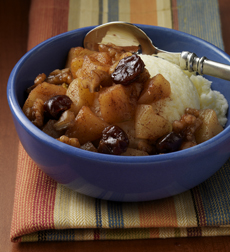
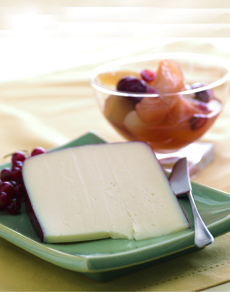
Top: Apple-Dried Cherry-Walnut Compote from Ziploc. Bottom: Compote served with a slice of cheese instead of a conventional fruit and cheese course. You can also spoon compote over a baked Brie. |
FRUIT COMPOTE RECIPE
Make some compote tonight!
SELECT. Pick three different seasonal fruits (we’re in-between seasons now, but apples, pears and mangoes are plentiful, and we’re adding some prunes for color interest and flavor variety). Peel and slice the mangoes (we retain the nutritious peel of the apples and pears).
COOK. In a large saucepan, cook 1 cup apple juice with cinnamon stick, cloves and/or other spices to boiling (if you don’t have apple juice, make a sugar syrup from 1 cup of water and the sugar).
ADD. Add the sliced fruit and 1/4 cup sugar or brown sugar, or half the amount of honey or agave nectar, and cook on medium heat until the fruit can be pierced with a fork (it’s up to you as to how al dente you like your cooked fruit). You can use less sugar and adjust the sweetness after cooking.
REMOVE. Remove from the heat; remove cinnamon stick. Mix in additional ingredients (zest, nuts, etc.) and serve warm or chilled.
DRIED FRUITS. If you’re making compote from dried fruits exclusively, cook in the hot liquid for 10 or 15 minutes; then turn off the heat and let the fruits sit in the liquid for 6 hours or overnight, until they soften.
You can also make a quick fruit compote in the microwave. Place ingredients in a covered microwave-safe dish for 2 minutes or longer, until your desired softness is achieved.
This post is dedicated to the memory of our beloved Nana, who inspired us with her passion for great cooking and baking—and who served us our first compote.
|
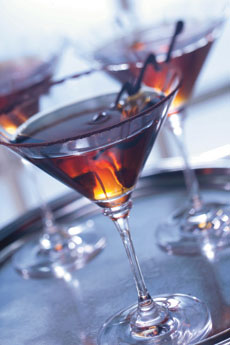
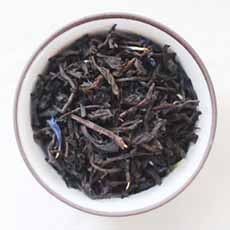 Earl Grey Tea Leaves[/caption]
Earl Grey Tea Leaves[/caption]

